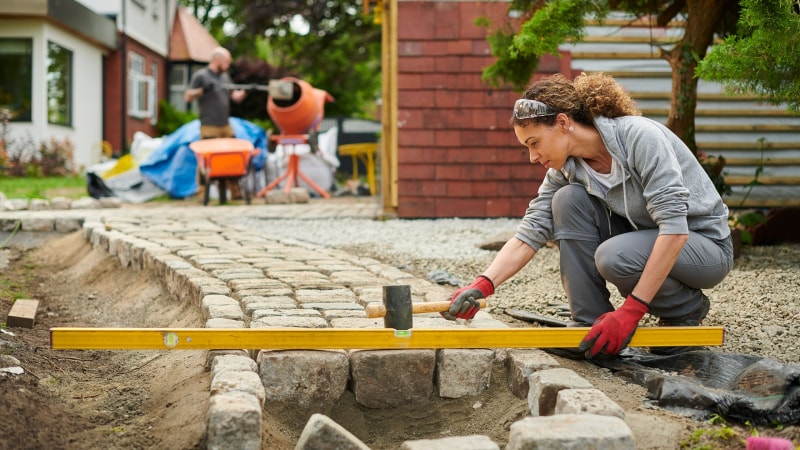Paying for emergency home repairs

Owning a home comes with a lot of freedom. Unlike renting, you get to decide everything about your property. However, when owning a home, you’re fully responsible for its maintenance and repairs. In practice, you’re your own landlord, management company and maintenance team all in one. In the event of an emergency home repair, this responsibility may quickly feel overwhelming. But with a bit of preparation and the right knowledge in your back pocket, financing emergency home repairs can potentially go from utterly daunting to downright manageable.
Preparing for home repairs
As a homeowner, upkeep is part of the job. As time goes on, your home will mature and require maintenance. This can range from issues with fixtures and appliances, to full structural repairs like a roof replacement. Whether your property is a fixer-upper or a new build, some of the most common (and often costly) emergency home repairs may include:
Roof leaks or roof damage
Roof repair costs vary based on repair type, materials, and location. Minor repairs typically cost $300-$1,500, moderate repairs $1,500-$3,000, and major repairs $3,000-$6,000 or more. These are estimates, and actual costs depend on specific roof conditions.ec-monarch-roof-2024 If the damage cannot be repaired, you may need a roof replacement. (The national average for roof replacement is $11,000, but costs may vary widely based on circumstances.)
Plumbing issues
Plumbing issues can be anything ranging from leaky faucets and clogged sinks to backed-up sewage or burst pipes. Plumbing repair costs in the U.S. generally range from $180 to $600, with major repairs potentially reaching $4,000. This variation is due to the labor intensity of different tasks. On average, plumbing services cost $315, but prices can vary from $100 for minor jobs like faucet replacements to $4,000 for significant issues like water main leaks.ec-monarch-roof-2024
Electrical issues
Similar to plumbing, electrical issues range from minor fixes like a blown fuse to emergency repairs for faulty wiring or overloaded circuits. If you experience a power outage or dangerous electrical surges causing shocks or broken appliances, this may be grounds for an emergency repair. Costs will depend on the size of your home and the extent of the repair. Electricians typically charge $50 to $130 per hour, with a service call fee of $100 to $200 for the first hour. Hiring an electrician costs between $150 and $600 for minor tasks, and $2,000 to $10,000 for major projects. Hourly rates vary based on the electrician's experience and location.ec-monarch-roof-2024
HVAC systems
HVAC is an acronym for your home's heating, ventilation and air conditioning system. If your HVAC goes out during extreme weather, this may require an emergency home repair. For example, if you live in a place with harsh winters and your heating system stops working before a snowstorm, you may reasonably view this as an emergency. The average cost to replace an HVAC system is $7,500, with prices ranging from $5,000 to $12,500 based on unit type, size, brand, and labor. Including new ductwork and features like a HEPA filter can increase the total cost to $22,000.ec-monarch-roof-2024
Broken windows or doors
In the event of a storm or an accident, you may experience broken windows or doors. A broken entryway into your home should almost always be fixed as soon as possible, and the price will depend on what type of window or door you have. The repair itself could be anywhere from a couple hundred to a couple of thousand dollars.
Water damage
Whether you live in a Special Flood Hazard Area (SFHA), your pipes burst or a load of laundry went awry, many homeowners deal with water damage at some point. In certain cases, it may be as simple as drying off the surfaces or replacing a carpet. In other cases, water damage could require extensive repairs, because water can lead to mold and other structural damage. Floods can strike any location, with even a single inch of water potentially causing $25,000 in damage. FEMA usually provides Individual Assistance grants between $3,000 and $6,000. However, flood damage is generally not covered by standard homeowner's insurance policies.ec-monarch-roof-2024
Pest infestations
Cockroaches, bedbugs, termites, spiders and other creepy crawlers may like your home just as much as you. Depending on where you live, this may be a major concern. If you happen to find yourself with an infestation, you may need to hire an exterminator to help mitigate the issue. There are pest-control services that offer one-time treatments typically in the hundreds of dollars, while some provide ongoing services for a monthly fee. Pest control costs differ by pest type due to unique challenges. Insect treatments, such as for ants and bed bugs, range from $100 to $500 per session based on chemicals and infestation severity. Rodent removal, including traps and follow-ups, costs $300 to $700. Termite treatments, addressing structural damage, range from $1,200 to $3,500. Wildlife removal, like raccoons and squirrels, typically costs $400 to $1,200, influenced by removal complexity and habitat adjustments.ec-invoicefly-pest-ctl
How to pay for home repairs
Ideally, paying for home repairs would be covered by your homeowners insurance (depending on the emergency) or from a personal savings account if your policy won’t cover them. Since repairs can be costly, a personal savings account may come in handy, but there are other options to consider.
Here are a few other ways to pay for home repairs if you need further assistance covering the cost of an emergency:
Home equity loan
Home Equity Loans or a Home Equity Line of Credit may be used for home repairs or renovation and may be a nice perk of owning a home in an emergency repair scenario, because you’re borrowing against the equity you’ve built up in your home. Home equity loans also come with predictable repayment schedules and fixed interest rates. They may also offer lower interest rates compared to other forms of borrowing, such as personal loans. Do note, however, that your home may serve as collateral if you're unable to repay your loan and that Chase doesn’t currently offer this type of home loan.
Emergency funds
Emergency funds are similar to personal savings accounts but are instead reserved for situations like an emergency home repair. If you have an emergency fund account and it outweighs other options, this may be a good time to tap into it. If you don’t have an emergency fund, don’t worry, there are other options.
Government loans or grants
The Residential Emergency Services to Offer (Home) Repairs to the Elderly (RESTORE) assists low-income senior homeowners by funding emergency repairs to eliminate hazardous conditions when they can't afford them. In response to a Notice of Funding Availability (NOFA) from New York State Homes and Community Renewal (HCR), non-profits and municipalities propose program designs to administer local RESTORE programs, detailing recipient selection, fund distribution, construction monitoring, and compliance.ec-invoicefly-pest-ctl
Support from friends and family
If you’re dealing with a true emergency, consider reaching out to family or friends to see if any of them can offer financial support. Keeping your home safe is important, and you may have someone willing to help with the cost of the repair.
Personal loan
A personal loan is an unsecured loan that does not require collateral. Personal loans are often used to meet unexpected costs and may be used to cover your emergency home repair. Do note that the terms of a personal loan depend on the borrower’s creditworthiness. If you’re unable to pay off a personal loan, you may end up with high interest payments that grow over time.
In summary
As a homeowner, emergency home repairs are often unavoidable. The good news is there are many options available to help you cover the cost of home repairs and keep your home safe. Remember to consider the pros and cons of each approach and how it might affect your overall financial health before deciding on the path that is right for you.



